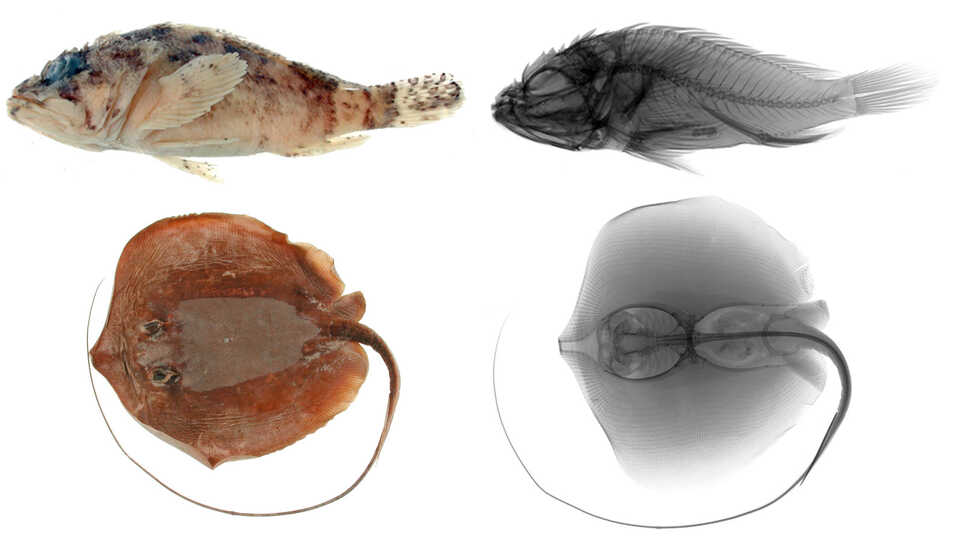
Search the Primary Types Imagebase
Introduction
The California Academy of Sciences Department of Ichthyology type collection contains over 37,000 specimens in over 6,000 lots, of which more than 1,600 are primary type lots. These were the focus of an imaging project funded by the National Science Foundation (NSF DBI-9876822). The type database consists of names that were published using CAS, Stanford University (SU), or Indiana University (IU) specimens as primary types (holotype, syntype, lectotype, or neotype). Most of the Indiana collection was acquired by the Academy in 1928, although part of the collection, including some types, were given to the Carnegie Museum and later transferred to the Field Museum of Natural History. The entire Stanford collection came to the Academy in 1970. Some images are lacking because the type specimen cannot be found, has been transferred to another institution (deaccessioned), or is currently on loan.
Three categories of images may be present: color photographs, radiographs, and original illustrations. In the case of syntypes, a single specimen is selected to represent the syntypic series. This is true even when the series is distributed in several discreet lots. The selection is based primarily on appearance for photography, so these may not be the best specimens for taxonomic purposes, and in some cases, may only represent one of two or more taxa actually present in the series. The project is essentially complete, although new images will be posted as old types are returned and new types are deposited here. Please direct any questions, comments, or corrections to David Catania, Sr. Collection Manager, Dept. of Ichthyology
How to Search the Imagebase
Taxonomic searches are by family or species name. Enter a family name directly, or click on "BROWSE BY FAMILY" to display a table of family names followed by the number of types in parentheses. Each family name is a hyperlink that retrieves images for all corresponding records. Species names include the complete binomial. Wild cards (*) can be used in the Family and Species Name fields. For example, if you wish to view all types in the genus Sebastodes, enter "sebastodes*". Likewise, should you be interested in all taxa with the species epithet jordani, enter "*jordani".
CAS, SU, or IU catalog numbers may be entered in the appropriate box (without the collection code). A range of catalog numbers may be specified. Use complete numbers (no commas) separated by a hyphen without any intervening spaces (ex: 23500-23600).
Search results are displayed with nomenclatural information from William N. Eschmeyer’s Catalog of Fishes, including links to full reference citations. Image file sizes are also displayed. A link with the general fish collection database is planned as soon as it comes on-line.
Project Evolution and Protocols
All photographs are taken with a digital camera. The project began with a Sony Mavica FD-91 (approx. 1 megapixel resolution). This was used for the Tetraodontiformes and most of the Perciformes. Subsequently we upgraded to a Nikon Coolpix 990 (3.3 megapixel resolution). Lighting was primarily done with a pair of Nikon SB-28 speedlights on light stands. New photographs are done with a Canon D-SLR. Each photograph is a montage of lateral, dorsal, and ventral views.
Specimens are x-rayed with a Faxitron model 43855C cabinet style unit. The radiographs are scanned using a Microtek Scanmaker 9600XL with a transmitted light adapter. Konica CM-H mammography film in a cassette with a single intensification screen (Konica MD-100) was initially used. Larger specimens (>200mm) required Konica CC film in a Konica KF cassette. Switching to Kodak SR-1 film yielded an increase in detail and exposure latitude. It is used in the MD-100 cassette. For larger specimens, Kodak Industrex-M in "ready packs" is the current choice.
The images are edited using Adobe Photoshop. The quality of photographs and radiographs both degrade noticeably when viewed in less than 16-bit color.
Use of the Images
All photographs and radiographs are copyright © California Academy of Sciences, with all rights reserved. No fees are required for scientific and not-for-profit educational uses, but written permission must be obtained for all uses. Please contact David Catania, Senior Collections Manager, Dept. of Ichthyology.
Share This
Learn more about the Ichthyology department.
Whom do I contact about visiting the collection for research, getting a loan, or requesting data or images?
ichthyology@calacademy.org
(415) 379-5277